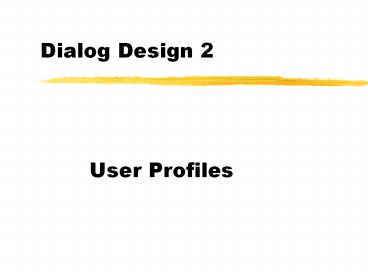Dialog Design 2 - PowerPoint PPT Presentation
Title:
Dialog Design 2
Description:
Dialog Design 2. User Profiles. End User Computing ... Toolsmith Build basic tool modules (often work for software houses) Design Approaches ... – PowerPoint PPT presentation
Number of Views:88
Avg rating:3.0/5.0
Title: Dialog Design 2
1
Dialog Design 2
- User Profiles
2
End User Computing
- Transfer the responsibility of accessing data and
generating the appropriate information from it
from system professional to business user. - Faster turnaround
- Better communication
- User ownership
3
User Classes
- DP Professionals write code for others
- DP Amateurs write code for their own use
- non_DP Trained Users use code written by others
4
End User Computing
Data
Model
Dialog
5
Roles
- Authorizer Approves acceptance and payment
- User Responsible for business solutions
- Intermediary Run system for user
- Builder Write code for application
- Technical Supports the development
Support tools - Toolsmith Build basic tool modules (often work
for software houses)
6
Design Approaches
- Warehouse
- Mart
- Application
- Professional Systems Analysts
- Business Analysts
- Business User
7
User Profiles
- Different users require different dialog design
philosophies - Naive Users
- Dedicated Users
- Professional Users
- Managerial Users
8
Naive User
- No formal training
- Low frustration tolerance
- Remembers little of last session
- Example automatic teller machine user
9
Naive Users
- Need
- Little chance of misinterpretation
- Little chance of destroying anything
- Use
- Mellow requests
- Limited responses
- Always reply
- Test with representative users
10
Dedicated User
- Trained
- Frequent user
- Harassed environment
- Rugged
- Bored
- Poorly paid
11
Dedicated Users
- Need
- Efficiency
- Accommodate learning
- Mindless operation
- Task accomplishment and quality of work life
- Humanized design
12
Dedicated Users
- Use
- Sequence tolerance
- Content flexibility synonyms, spelling,
learning - Procedure tolerance humble messages, user
tested, alternative helps, no self-destructs,
audit trails - Pacing
13
Professional Users
- Experts in some area
- Comfortable with their own ability
- Comfortable with technology
- Want control
14
Professional Users
- Want
- Powerful tools
- Good metadata
- Control and flexibility
- Information
15
Professional Users
- Use
- Command language
- Fast technology
- Maximum access and control
- Good documentation
16
Managerial Users
- No training
- Comfortable with PEOPLE
- Impatient
- Non-rugged
- Short time segments
- Casual usage
17
Managerial Users
- Need
- Ease of starting
- Little chance of embarrassment
- Easy recovery
- Much change and evolvement
- Belief that system has value
18
Managerial Users
- Use
- Graphics
- Macros
- Isolation
- Hard copies
- Alternative communication technologies voice,
pen, etc.
19
Issues
- Relational vs. Dimensional
- Single Table vs. Star vs. Snowflake
- Report generator vs. Data base software
- Coding vs. Menu































